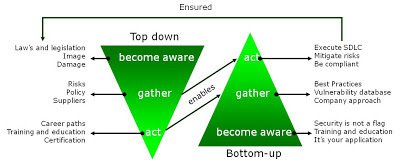Top-down and Bottom-up Software Testing approaches
Types of Software Testing Approaches :
- Top-down
- Bottom-up
Top-down and bottom-up are both strategies of information processing and knowledge ordering, used in a variety of fields including software, humanistic and scientific theories (see systemics), and management and organization. In practice, they can be seen as a style of thinking and teaching.
Top-down approach
A top-down approach (also known as stepwise design or deductive reasoning, and in many cases used as a synonym of analysis or decomposition) is essentially the breaking down of a system to gain insight into its compositional sub-systems. In a top-down approach an overview of the system is formulated, specifying but not detailing any first-level subsystems. Each subsystem is then refined in yet greater detail, sometimes in many additional subsystem levels, until the entire specification is reduced to base elements. A top-down model is often specified with the assistance of "black boxes", these make it easier to manipulate. However, black boxes may fail to elucidate elementary mechanisms or be detailed enough to realistically validate the model. Top down approach starts with the big picture. It breaks down from there into smaller segments.
Bottom-up approach
A bottom-up approach (also known as inductive reasoning, and in many cases used as a synonym of synthesis) is the piecing together of systems to give rise to grander systems, thus making the original systems sub-systems of the emergent system. Bottom-up processing is a type of information processing based on incoming data from the environment to form a perception. Information enters the eyes in one direction (input), and is then turned into an image by the brain that can be interpreted and recognized as a perception (output). In a bottom-up approach the individual base elements of the system are first specified in great detail. These elements are then linked together to form larger subsystems, which then in turn are linked, sometimes in many levels, until a complete top-level system is formed. This strategy often resembles a "seed" model, whereby the beginnings are small but eventually grow in complexity and completeness. However, "organic strategies" may result in a tangle of elements and subsystems, developed in isolation and subject to local optimization as opposed to meeting a global purpose.
 |
| Click on the image for zoom view |
What are the differences between Top down and Bottom up approaches ?
 |
| Click on the image for zoom view |
 |
| Click on the image for zoom view |
Example 1 :These are two design approaches, which can be explained as:
You can imagine a tree like structure , in which when you are following top-down approach you move from root node to leaf node and when you follow bottom-up approach you follow leaf node to root node.
a) Top-down approach:
In this an overview of the system is first formulated, specifying but not detailing any first-level subsystems.
Each subsystem is then refined in yet greater detail, sometimes in many additional subsystem levels, until the
entire specification is reduced to base elements.
b) Bottom-up approach:
In this approach the individual base elements of the system are first specified in great detail. These elements are then linked together to form larger subsystems, which then in turn are linked, sometimes in many levels, until a complete top-level system is formed.

thanks
ReplyDeleteVery good information. Its very useful for me. We need learn from real time examples and for this we choose good training institute, we need to learn from experts . So we make use of demo classes . Recently we tried software testing demo class of Apponix Technologies.
ReplyDeletehttps://www.apponix.com/Software-Testing/Software-Testing-Training-in-Bangalore.html
Thank you for sharing valuable information
ReplyDeleteSoftware testing company
Automation testing company
Manual testing company
It's great to be here and to learn more about software testing. software testing training in chennai
ReplyDeleteThanks for sharing this informative content , Great work
ReplyDeleteTo crack scrum master interview : Agile coach interview questions
Nice post. To know more about SDLC process models
ReplyDeleteAnkara
ReplyDeleteBolu
Sakarya
Mersin
Malatya
İRS0
Eskişehir
ReplyDeleteDenizli
Malatya
Diyarbakır
Kocaeli
HBVGJB
Kırşehir Lojistik
ReplyDeleteHakkari Lojistik
Kars Lojistik
Konya Lojistik
Kilis Lojistik
D3UQJ
E6C6B
ReplyDeleteEryaman Fayans Ustası
Kırklareli Şehir İçi Nakliyat
Rize Şehir İçi Nakliyat
Antep Evden Eve Nakliyat
Burdur Evden Eve Nakliyat
Mardin Lojistik
Tekirdağ Fayans Ustası
Kırklareli Şehirler Arası Nakliyat
Muğla Lojistik
B999C
ReplyDeleteElazığ Şehir İçi Nakliyat
Kırıkkale Şehirler Arası Nakliyat
Ünye Kurtarıcı
Isparta Şehirler Arası Nakliyat
Bitget Güvenilir mi
Kırıkkale Şehir İçi Nakliyat
Sinop Şehir İçi Nakliyat
Bitexen Güvenilir mi
Ünye Oto Elektrik
D1350
ReplyDeletekonya bedava sohbet siteleri
tunceli goruntulu sohbet
sohbet chat
bartın mobil sesli sohbet
yalova telefonda canlı sohbet
uşak canlı görüntülü sohbet uygulamaları
parasız sohbet
izmir canlı görüntülü sohbet
maraş sesli sohbet odası
D0886
ReplyDeletekonya canlı sohbet odası
Karaman Sohbet Muhabbet
sohbet
kırklareli canli sohbet chat
Hatay Ücretsiz Görüntülü Sohbet Uygulamaları
Aydın Görüntülü Sohbet Canlı
Giresun Sesli Mobil Sohbet
igdir ücretsiz görüntülü sohbet uygulamaları
canlı sohbet odaları
71E21
ReplyDeleteBitcoin Kazanma
Bitcoin Kazma Siteleri
Twitch İzlenme Satın Al
Kripto Para Kazanma
Bitcoin Madenciliği Nasıl Yapılır
Tumblr Beğeni Hilesi
Facebook Beğeni Hilesi
Btcturk Borsası Güvenilir mi
NWC Coin Hangi Borsada
57CD6
ReplyDeleteParasız Görüntülü Sohbet
Sui Coin Hangi Borsada
Linkedin Takipçi Satın Al
Clubhouse Takipçi Hilesi
Coin Çıkarma Siteleri
Binance Ne Zaman Kuruldu
Expanse Coin Hangi Borsada
Sonm Coin Hangi Borsada
Facebook Sayfa Beğeni Satın Al
00A9C
ReplyDeleteGate io Borsası Güvenilir mi
Paribu Borsası Güvenilir mi
Youtube Abone Hilesi
Youtube İzlenme Satın Al
Satoshi Coin Hangi Borsada
Bitcoin Madenciliği Nedir
Binance Kaldıraçlı İşlem Nasıl Yapılır
Coin Kazanma
Xcn Coin Hangi Borsada
شركة تنظيف مجالس بالدمام djnKXaN2ki
ReplyDeleteشركة عزل اسطح بابها 83VpMctDDT
ReplyDelete1FA173926D
ReplyDeleteDexTools
Trading View Download
RocketPool
Debank
Harmony One
Trading View
Trading View Download
Mullvad
Poocoin
0AC4A83BBE
ReplyDeletegreen man gaming
ragnarok online
ikariam
nitrado
crossout
lineage2
world of tanks
war thunder
fanatical